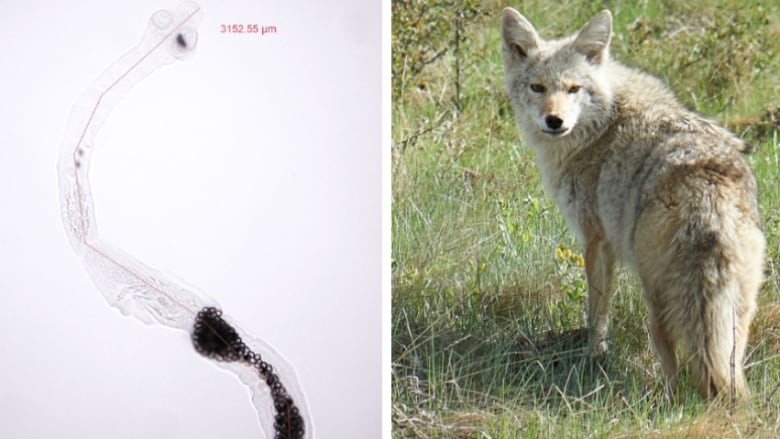Tapeworm in coyotes that can cause fatal tumours in people 'has spread all over Alberta'
'This European strain is known to be very virulent for people, and now is everywhere in wildlife'

The European strain of a tiny tapeworm that can make people seriously ill and even killthem is now common in wildlife throughout Alberta, Calgary researchers say.
The researchwas published in a letter in the New England Journal of Medicine. The research,led by the University of Calgary's faculty of veterinary medicine, found that theparasitic tapeworm calledEchinococcus multilocularisis now prevalent in Western Canada, after being first spotted there in 2012 and longcommon in Europe.
The first humancase in Canada of a tumour-like disease caused by the tapeworm, human alveolar echinococcosis (AE), was diagnosed in 2013.
Dr. Claudia Klein, one of the study's authors, said her lab now has DNA samples from most of the 14 people inCanada who have been diagnosed to date with the potentially fatal parasite.

"If you're exposed to the tapeworm eggs, you can become infected with it," she said.
"The problem is, you won't really notice for years later that you're infected, and then your liver will be infiltrated by tumour-like lesions from that tapeworm."
If the disease isn't discovered and treated, the mortality rate is 90 per cent, Klein said.
"So for humans, it's a very serious condition."
Klein said experts had assumed until recently that cases of AE were not showing up in North America because the strain of tapeworm on this continent is not as virulent to people.
"But the story has really changed dramatically over the past five years," she said.
Klein says her lab is now finding, overwhelmingly, the European strain when researchers examine coyote feces and rodent livers.
"So, that was a very surprising finding," she said.
Klein collaborated on the research with Dr. Alessandro Massolo, who was teachingwildlife health ecology at the U of Cand is nowat the University of Pisa in Italy,and withDr. Kinga Kowalewska-Grochowska of the University of Alberta.
Strain arrives in dogs from Europe
It's believed the strain has beenarriving in Canada in dogs that are brought over from Europe, and in foxes that were imported decades ago for hunting.
Infected foxes and coyotes shed the tapeworm's eggs in their feces, which are eaten by small rodents such as deer mice and voles.
In those animals, which are considered intermediate hosts, the eggs become larvae that form in large cysts. The cysts eventually kill the rodent or render it vulnerable to prey. If those preying animals are coyotes or foxes, the larvae they ingest become adult tapeworms, closing the circle.
Dogscan get the parasite in turn through contact with infected coyote or fox feces or by eating infected dead rodents.
The wormscan be passed on to people on fruit, by handling contaminated soil or through an infected dog's fur, which can be contaminated with worm eggs too small to see.
The human form of the diseasedevelops slowly over several years and causes multiplying lesions in the body, usually in the liver.
"This evidence is the smoking gun that these AE cases are locally acquired, and they are caused by an invasive strain coming from Europe that has spread all over Alberta," said co-authorDr. Alessandro Massolo.
"So, this European strain is known to be very virulent for people, and now is everywhere in wildlife and even in dogs. From a public health perspective, to me is very relevant, because it has to change the way you assess the risk for this disease."
Klein says hunters and trappers are at an elevated risk of getting the disease from wild animals, while veterinarians can pick it up from dogs, which can also host the tapeworms.
'There's no need for panic'
"In dogs, we've found a low prevalence of that tapeworm," she said.
Pet owners can protect themselves by washing their hands after picking up their dog's waste.
"There's no need for panic or anything, just to be aware of it," she said.
But hunters and trappers should get their blood tested for the presence of antibodies, Kleinsaid. "The earlier you find it the better."
The infection can be treated with anti-parasitic medication.
People with compromised immune systems are alsomore vulnerable to the disease
Corrections
- The University of Calgary originally said in a news release that cats could get the tapeworm and spread it. The university later clarified that only canids, such as foxes, dogs and wolves, can get the parasite.Jul 25, 2019 2:06 PM MT
With files from Canadian Press












_(720p).jpg)


 OFFICIAL HD MUSIC VIDEO.jpg)
.jpg)



























































































